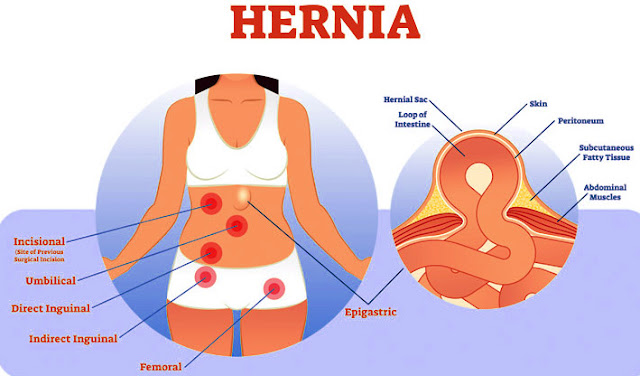HERNIA is a condition where part of the abdominal content bulges through a weak point on the abdominal wall. It can occur near the groin, around the belly button, or through a past surgical scar.
Inguinal hernia is a condition where abdominal fat (omentum) or part of the intestines bulges through a weak point on the abdominal wall near the groin area.
According to MSU Medical Centre medical consultant general and colorectal surgeon Dr Mohd Zailani Mat Hassan, “Men are 25 times more likely than women to be present with inguinal hernia. Adult males over 40 are much more likely than females to develop direct inguinal hernias.”
There are two types of inguinal hernias:
Indirect inguinal hernia, which is caused by a defect in the abdominal wall through an inguinal ring relating to a birth defect Direct inguinal hernia, which occurs in adult males and is owed to a weakness in the abdominal wall muscles; it may develop over time or be caused by straining or heavy weight lifting over time
Signs and symptoms
Usually patients have bulges in the groin area. At an early stage, bulging occurs only during coughing or straining, and spontaneously disappears. This condition is called reducible inguinal hernia.
As the hernia advances, an intestinal content of fat is trapped inside the “hernial sac” or the scrotum. This is called irreducible, obstructed, or even strangulated inguinal hernia, in which stage the patient will experience persistent bulging in the groin or scrotal area, severe pain and vomiting.
Causes and risk factors of inguinal hernia
A weakened abdominal muscle at the affected areas may be a major predisposing factor. Some risk factors that can increase the chances of getting inguinal hernia include:
- Gender (men are more predisposed than women) Obesity
- Chronic constipation Chronic cough
- Chronic urinary bladder outlet obstruction, e.g., benign prostate hyperplasia
- Premature birth Previous history of inguinal hernia
- Occupation-related – heavy weight lifting
Two possible serious complications if hernia is left untreated are:
Incarcerated inguinal hernia, which happens when tissue becomes stuck in the groin and is not reducible – it cannot be pushed back into place
Strangulated inguinal hernia, a life-threatening condition that requires emergency medical care; this is when the intestine in an incarcerated hernia has its blood flow cut off, which may lead to intestinal gangrene (“dead” tissue).
Diagnosis and treatment
In most cases, diagnosis is made from history and clinical examinations. When the diagnosis is doubtful, then medical imaging is required, with ultrasonography being the first choice.
Surgery is the primary treatment for inguinal hernias.
It is a common operation and a highly successful procedure when performed by a well-trained surgeon.
Surgical options are either an open inguinal herniorrhaphy or a laparoscopic inguinal herniorrhaphy. In open inguinal herniorrhaphy, a 5cm-long incision is made over the abdomen near the groin. In laparoscopic inguinal herniorrhaphy, multiple smaller abdominal incisions are made (at least three, approximately 1cm each).
The goal of either surgical approach is to return the internal abdominal tissue(s) back into the abdominal cavity and repair the abdominal wall defect. Mesh is commonly placed to reinforce the abdominal wall.
There are advantages and disadvantages of both techniques. Patient factors, surgical expertise, and cost incurred will determine the selection criteria.
Prevention of inguinal hernia
As inguinal hernia relates to abdominal wall muscles and inguinal ring birth defect, reducing abdominal pressure may substantially prevent inguinal hernia from occurring.
Maintain a healthy body weight:
Inguinal hernia is a condition where abdominal fat (omentum) or part of the intestines bulges through a weak point on the abdominal wall near the groin area.
Obesity is a potential hazard as it can impose extra pressure on the abdomen. Regular exercise and a good healthy lifestyle are important to maintaining good body weight.
Be careful while exercising: Some exercises such as squats can put undue strain on the abdominal wall. Exercises involving fast movements or high-intensity workouts also increase your risk of developing hernia. Use proper gear and attire during abdominal exercises.
l Avoid lifting heavy weights: Heavy weight lifting puts unneeded pressure on the abdominal muscles. If it is still required, consider bending down at the knees rather than lifting from the waist up to distribute the weight.
l Eat fibre-rich foods: Constipation can put undue strain on the abdomen during bowel movement and thus increase hernia risk. Eating fibrous foods such as whole grains, fresh fruits (bananas, apples, oranges), vegetables, and nuts can help regulate bowel movements. Staying well-hydrated is essential to preventing constipation.
Consult your doctor if you experience difficulty when urinating:
Urination difficulties, increased urination frequency especially at night, or feelings of incomplete emptying may indicate an enlarged prostate, particularly among men aged 50 years and above. These symptoms can increase pressure on the abdomen by causing strain during urination.



